|
The Man with Wheels in His Head
by Bob Brooke
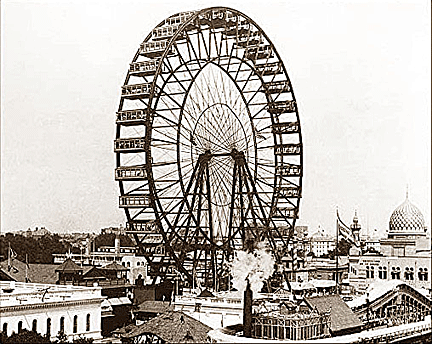 June
21, 1893 dawned clear and bright, and for a little while, it seemed to
the men who had labored so tirelessly, that the sun rising over Lake
Michigan was rotating around the axle of the Great Wheel. Important
investors and various dignitaries dressed in their Sunday best, were
gathered about. On the speakers’ platform were the officers of the
company and other important persons. The last speaker was George
Washington Gale Ferris Jr., a 33-year-old engineer from Pittsburgh,
creator of the Great Wheel at the World Columbian Exposition in Chicago.
In this moment of triumph, his speech told how he “had gotten the wheels
out of his head and made them a living reality.” Ferris’ wife, Margaret,
handed him a golden whistle which he blew as the signal to start up the
Great Wheel. The Iowa State Band struck up “America” and to the cheers
of the assembled thousands, the Great Wheel slowly and majestically
revolved, towering above them in its magnificence. June
21, 1893 dawned clear and bright, and for a little while, it seemed to
the men who had labored so tirelessly, that the sun rising over Lake
Michigan was rotating around the axle of the Great Wheel. Important
investors and various dignitaries dressed in their Sunday best, were
gathered about. On the speakers’ platform were the officers of the
company and other important persons. The last speaker was George
Washington Gale Ferris Jr., a 33-year-old engineer from Pittsburgh,
creator of the Great Wheel at the World Columbian Exposition in Chicago.
In this moment of triumph, his speech told how he “had gotten the wheels
out of his head and made them a living reality.” Ferris’ wife, Margaret,
handed him a golden whistle which he blew as the signal to start up the
Great Wheel. The Iowa State Band struck up “America” and to the cheers
of the assembled thousands, the Great Wheel slowly and majestically
revolved, towering above them in its magnificence.
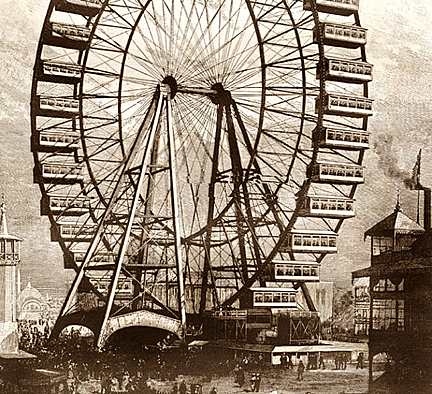 The
Great Wheel ran without difficulty until November 6, 1893. A trip
consisted of one revolution, during which it made six stops for loading,
followed by one nine-minute, nonstop revolution. For this riders paid 50
cents. The
Great Wheel ran without difficulty until November 6, 1893. A trip
consisted of one revolution, during which it made six stops for loading,
followed by one nine-minute, nonstop revolution. For this riders paid 50
cents.
On a clear day, patrons could not only see the Fairgrounds and City of
Chicago, but miles out onto Lake Michigan and the surrounding states of
Illinois, Wisconsin, Indiana and Michigan. Attendance on dark smoky days
was nearly as heavy as on good days, so it seemed the Wheel, itself, was
more of an attraction than the view it offered. Ferris adorned his Wheel
with 3000 of Thomas Edison’s new incandescent light bulbs which made it
a dazzling sight as they blinked on and off.
How It All Began
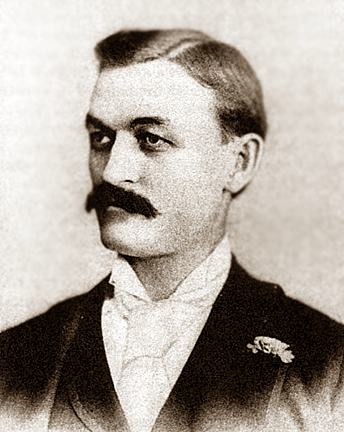 In
late 1890, Daniel Burnham, the eminent architect charged with turning a
boggy square mile of Chicago into a world-dazzling showpiece, assembled
an all-star team of designers and gave them one directive: “Make no
little plans.” Burnham ‘s competitor was the Eiffel Tower, an elegant
wrought-iron structure erected the year before in Paris as the grand
gateway to the Exposition Universelle and rising over a thousand feet
into the air. In
late 1890, Daniel Burnham, the eminent architect charged with turning a
boggy square mile of Chicago into a world-dazzling showpiece, assembled
an all-star team of designers and gave them one directive: “Make no
little plans.” Burnham ‘s competitor was the Eiffel Tower, an elegant
wrought-iron structure erected the year before in Paris as the grand
gateway to the Exposition Universelle and rising over a thousand feet
into the air.
But nobody in the United States had an idea of what could compete with
the Eiffel Tower. Burnham told a group of engineers employed on the
project that they needed to come up with “something novel, original,
daring and unique.” Ferris, whose company was in charge of inspecting
the steel used by the fair, sketched a huge revolving steel wheel. He
showed his idea to Burnham, who balked at the slender rods that would
carry people to a height taller than the Statue of Liberty.
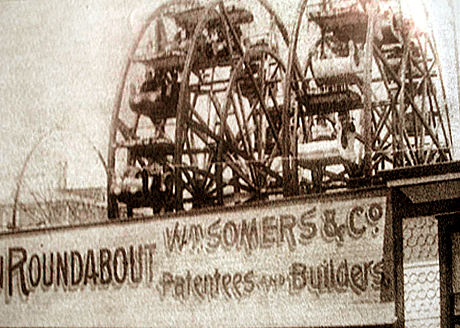 But
Ferris wasn’t the first to imagine such a wheel. In fact, a carpenter
named William Somers had been building 50-foot wooden wheels at Asbury
Park, Atlantic City and Coney Island. He called his wheel a Roundabout
and patented his design. But Ferris had been challenged to think big. He
spent $25,000 of his own money on safety studies, hired more engineers,
and recruited investors. On December 16, 1892, Burnham chose his wheel
for the fair. It measured 250 feet in diameter, and carried 36 cars,
each capable of holding 60 people. But
Ferris wasn’t the first to imagine such a wheel. In fact, a carpenter
named William Somers had been building 50-foot wooden wheels at Asbury
Park, Atlantic City and Coney Island. He called his wheel a Roundabout
and patented his design. But Ferris had been challenged to think big. He
spent $25,000 of his own money on safety studies, hired more engineers,
and recruited investors. On December 16, 1892, Burnham chose his wheel
for the fair. It measured 250 feet in diameter, and carried 36 cars,
each capable of holding 60 people.
George Washington Gale Ferris Jr. rode on Somers' wheel in Atlantic City
prior to designing his wheel for the World's Columbian Exposition. In
1893, Somers filed a lawsuit against Ferris for patent infringement,
however Ferris and his lawyers successfully argued that the Ferris Wheel
and its technology differed greatly from Somers' wheel, so the judge
dismissed the case.
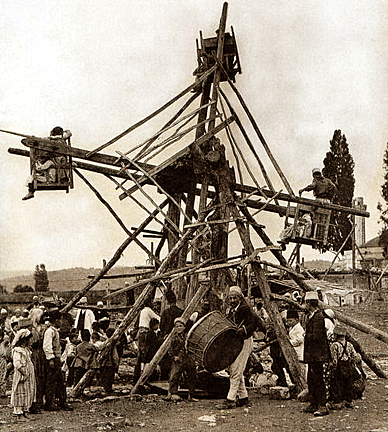 Ferris’s
invention, eventually referred to as the Ferris Wheel after him,
consisted of a rotating upright wheel with multiple passenger-carrying
components, commonly referred to as passenger cars, cabins, tubs,
capsules, gondolas, or pods, attached to the rim in such a way that as
the wheel turned, they stayed upright by gravity. Ferris’s
invention, eventually referred to as the Ferris Wheel after him,
consisted of a rotating upright wheel with multiple passenger-carrying
components, commonly referred to as passenger cars, cabins, tubs,
capsules, gondolas, or pods, attached to the rim in such a way that as
the wheel turned, they stayed upright by gravity.
"Pleasure wheels", whose passengers rode in chairs suspended from large
wooden rings turned by strong men, may have originated in 17th-century
Bulgaria. After that, Great Wheels became part of festivals in India,
Persia, and Turkey.
A Frenchman, Antonio Manguino, introduced the idea to America in 1848,
when he constructed a wooden pleasure wheel to attract visitors to his
fair in Walton Spring, Georgia.
More than 100,000 parts went into Ferris’ wheel, the largest of which
was its 45.5-foot, 89,320-pound axle that had to be hoisted onto two
towers 140 feet in the air. The entire wheel structure stood 264 feet
tall. For 19 weeks after its opening, over 1.4 million people rode it
and viewed an aerial panorama few had ever seen.
Ferris’ Background
Ferris was a graduate of Rensselaer Polytechnic Institute and a
Pittsburgh, Pennsylvania, bridge-builder. He began his career in the
railroad industry and then pursued an interest in bridge building.
Ferris understood the growing need for structural steel and founded
G.W.G. Ferris & Co. in Pittsburgh, a firm that tested and inspected
metals for railroads and bridge builders.
The Great Wheel
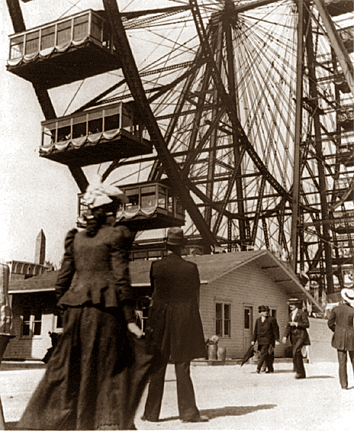 The
Great Wheel rotated on an axle comprising what was then the world's
largest hollow forging, manufactured in Pittsburgh by the Bethlehem Iron
Company, together with two 16-foot-diameter cast-iron spiders weighing
53,031 pounds. Each of its 36 cars, able to accommodate up to 60 people,
had 40 revolving twisted-wire chairs, giving a total capacity of 2,160.
The wheel carried some 38,000 passengers daily. The
Great Wheel rotated on an axle comprising what was then the world's
largest hollow forging, manufactured in Pittsburgh by the Bethlehem Iron
Company, together with two 16-foot-diameter cast-iron spiders weighing
53,031 pounds. Each of its 36 cars, able to accommodate up to 60 people,
had 40 revolving twisted-wire chairs, giving a total capacity of 2,160.
The wheel carried some 38,000 passengers daily.
But designing the Wheel was no easy task, even for experienced
engineers. Stresses for such a structure had never been determined, so
they had to go with established principles. Ferris also had difficulties
finding financing because the U.S. was in the midst of a severe
depression at the time But his quiet yet enthusiastic manner inspired
confidence, and eventually he was able to raise $600,000 for the
project.
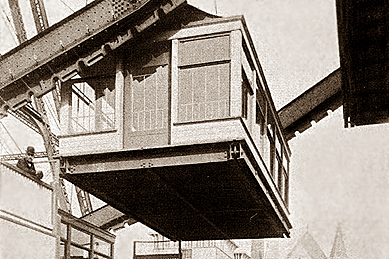 Armed
with completed plans and guaranteed financing, Ferris approached the
Columbian Exposition’s Ways and Means Committee in the spring of 1892.
But the Committee treated his ideas as those of a lunatic. They called
him “The Man with Wheels in his Head.” But Ferris persisted, and finally
the Committee granted him a concession to build the Wheel, not on the
main Fairgrounds in Jackson Park, but on the Midway along Central
Avenue. By the terms of this concession, granted December 16,1892, The
Ferris Wheel Company would retain $300,000 received from the sale of
tickets, after which it had to pay one-half of the gross receipts to the
Exposition. Armed
with completed plans and guaranteed financing, Ferris approached the
Columbian Exposition’s Ways and Means Committee in the spring of 1892.
But the Committee treated his ideas as those of a lunatic. They called
him “The Man with Wheels in his Head.” But Ferris persisted, and finally
the Committee granted him a concession to build the Wheel, not on the
main Fairgrounds in Jackson Park, but on the Midway along Central
Avenue. By the terms of this concession, granted December 16,1892, The
Ferris Wheel Company would retain $300,000 received from the sale of
tickets, after which it had to pay one-half of the gross receipts to the
Exposition.
By this time it was already midwinter and only four months until the
opening of the Exposition. Since no single metal shop could do all the
work, Ferris’ Company awarded contracts to several different firms, each
chosen for its ability to do handle a particular job. Each part had to
be precisely made as few could be assembled until they were on site.
Ferris called on 32-year-old Luther Rice, only three years out of
engineering school, to become Construction Chief of the project. The
foundation work proceeded slowly in the face of the most severe winter
that Chicago had experienced in many years.
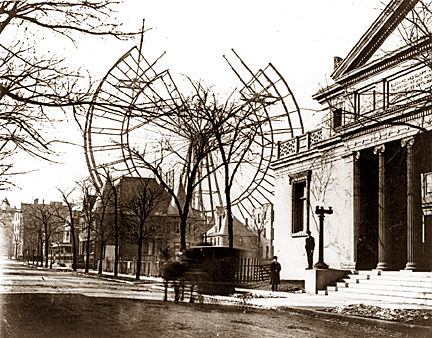 The
frost at the Wheel site was three feet deep and under it lay 20 feet of
saturated sand, which could, when disturbed by construction activities
or vibration, suddenly behave like the quicksand. Rice kept pumps
running day and night. He had live steam piped in to thaw the frozen
sand and later to keep the concrete from freezing before it had set.
Workers drove piles a further 32 feet to bedrock and upon steel beams
resting on these piles workers built the eight 20 by 20 by 35-foot
monolithic reinforced concrete and masonry piers which were to support
the towers which in turn would support the axle. The
frost at the Wheel site was three feet deep and under it lay 20 feet of
saturated sand, which could, when disturbed by construction activities
or vibration, suddenly behave like the quicksand. Rice kept pumps
running day and night. He had live steam piped in to thaw the frozen
sand and later to keep the concrete from freezing before it had set.
Workers drove piles a further 32 feet to bedrock and upon steel beams
resting on these piles workers built the eight 20 by 20 by 35-foot
monolithic reinforced concrete and masonry piers which were to support
the towers which in turn would support the axle.
On March 18, 1893, the Wheel’s axle arrived from Pittsburgh. At 45½ feet
long and 33 inches in diameter, it was the largest hollow forged object
at the time. Four and one-half feet from each end it carried two 16-foot
diameter cast-iron spiders weighing 53,031 pounds. On March 20, Rice’s
men completed placing the first tower post. Shortly after came the
problem of raising the axle. In an amazingly short two hours, cranes
hoisted the immense axle assembly to the top of the 140 feet high towers
and placed it neatly in its sturdy pillow blocks.
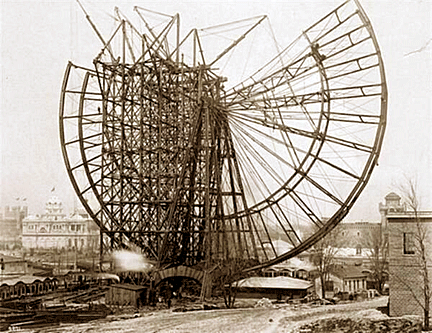 Next
came the involved process of assembling the actual wheel. Meanwhile,
workers constructed the Wheel’s power plant 700 feet away outside the
grounds. Ten-inch steam pipes fed two 1000 horse power reversible
engines—one to be used for driving the wheel and the second held in
readiness as an emergency reserve. Ferris employed a Westinghouse air
brake to control the Wheel and to hold it motionless when desired. Next
came the involved process of assembling the actual wheel. Meanwhile,
workers constructed the Wheel’s power plant 700 feet away outside the
grounds. Ten-inch steam pipes fed two 1000 horse power reversible
engines—one to be used for driving the wheel and the second held in
readiness as an emergency reserve. Ferris employed a Westinghouse air
brake to control the Wheel and to hold it motionless when desired.
When the Columbian Exposition opened on May 1,1893, the steelworkers
where still working high on the growing Wheel. By June 9, the Wheel, as
yet without cars, was ready for a trial run. At 6:00 P.M. in the evening
with trusted men stationed at various points, Rice ordered the steam
turned on. Slowly, without a creak or groan and only the soft clink of
the chain, the great wheel began to turn. In 20 minutes, it had
completed one revolution. When he got the word, Ferris, who was in
Pittsburgh at the time, immediately ordered the 36 cars hung.
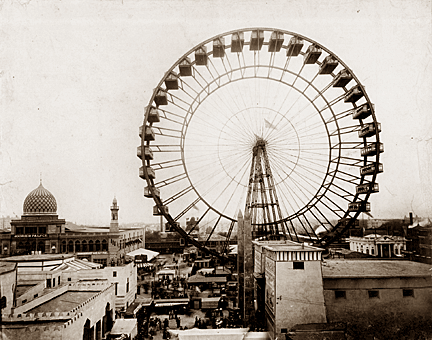 The
sight of it moving slowly on that summer evening excited the crowds.
From all sides fairgoers shouted and cheered. On June 10, workers hung
the first car. And by June 13, 20 more had been added and the offices
and loading platforms practically had been completed. The
sight of it moving slowly on that summer evening excited the crowds.
From all sides fairgoers shouted and cheered. On June 10, workers hung
the first car. And by June 13, 20 more had been added and the offices
and loading platforms practically had been completed.
The cars were 24 feet long, 13 feet wide, and 10 feet high, and weighed
26,000 pounds. Each car carried fancy twisted wire chairs for 38 of the
60 passengers. The five large plate glass windows on each side had heavy
screens and the doors at each end had secure locks. Each car had
firefighting equipment on board as a safeguard. Six platforms helped to
speed loading and unloading, with a guard at each to signal the operator
when his car was filled and locked. Conductors rode in each car to
answer patrons’ questions or, if necessary, to calm their fears.
On June 11, with six cars hung, Daniel Burnham arrived to take a trial
trip and Margaret Ferris went along. At 6 P.M. on June 13, Rice held a
trial trip for the local press who were very enthusiastic in their
praise.
The Great Wheel’s End
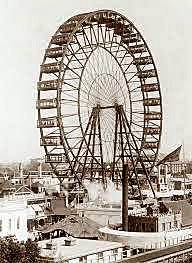 Though
the Exposition closed on November 1, 1893, the Wheel stood idle on the
Midway until April 29, 1894. The Ferris Company’s failure to remove the
Wheel after the close of the fair brought complaints from many who
considered it to be an eyesore. Ferris had it dismantled and stored
until the following year. It took 86 days and cost $14,833 to dismantle
it. Beginning in July, 1895, Ferris had his Wheel rebuilt on Chicago's
North Side, adjacent to Lincoln Park, next to an exclusive neighborhood
only 20 minutes from the city’s principal hotels and railway stations.
The Directors sold bonds hoping to landscape the grounds, build a
restaurant, a band shell, a Vaudeville theater, and paint the Wheel and
cars. Most of these improvements were never made, and the company began
to lose money rapidly, as patrons failed to materialize. Though
the Exposition closed on November 1, 1893, the Wheel stood idle on the
Midway until April 29, 1894. The Ferris Company’s failure to remove the
Wheel after the close of the fair brought complaints from many who
considered it to be an eyesore. Ferris had it dismantled and stored
until the following year. It took 86 days and cost $14,833 to dismantle
it. Beginning in July, 1895, Ferris had his Wheel rebuilt on Chicago's
North Side, adjacent to Lincoln Park, next to an exclusive neighborhood
only 20 minutes from the city’s principal hotels and railway stations.
The Directors sold bonds hoping to landscape the grounds, build a
restaurant, a band shell, a Vaudeville theater, and paint the Wheel and
cars. Most of these improvements were never made, and the company began
to lose money rapidly, as patrons failed to materialize.
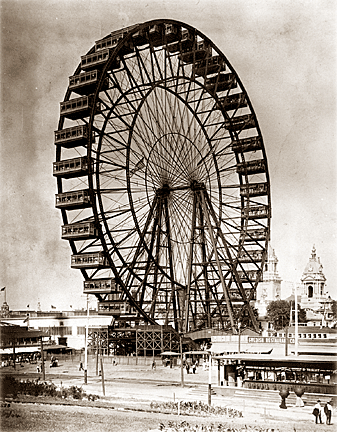 But
when the fair gates closed, Ferris became immersed in a tangle of
wheel-related lawsuits about debts he owed suppliers and that the fair
owed him. In 1896, bankrupt and suffering from typhoid fever, he died at
age 37. A wrecking company bought the wheel and sold it to the 1904
Louisiana Purchase Exposition in St. Louis. Two years later, it was
dynamited into scrap. But
when the fair gates closed, Ferris became immersed in a tangle of
wheel-related lawsuits about debts he owed suppliers and that the fair
owed him. In 1896, bankrupt and suffering from typhoid fever, he died at
age 37. A wrecking company bought the wheel and sold it to the 1904
Louisiana Purchase Exposition in St. Louis. Two years later, it was
dynamited into scrap.
The Great Wheel operated at its North Side location from October 1895
until 1903, when it was again dismantled, then transported by rail to
St. Louis for the 1904 World's Fair. and finally destroyed with dynamite
controlled demolition on May 11, 1906.
So died the one and only official Ferris wheel. But the invention lives
on today in smaller portable versions inspired by the pleasure Ferris
made possible. But at boardwalks, county fairs and parish festivals
around the globe millions whirl through the sky in neon-lit wheels and
know the sensation that, years later.
<
Back to More Antique Spotlights
Next
Article >
|
